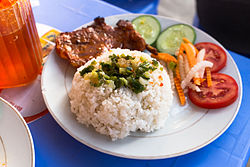


Cơm tấm served with grilled pork and fish sauce.
| |
| Alternative names | Cơm sườn |
|---|---|
| Course | Breakfast Lunch Dinner |
| Place of origin | Vietnam |
| Region or state | Southern Vietnam |
| Main ingredients | Broken rice, grilled rib, fish sauce with sugar, pickled carrots, oil garnish |
Cơm tấmorcom tam (US: /kʌm təm/; Vietnamese: [kəːm tə̌m]) is a Vietnamese dish made from rice with fractured rice grains. Tấm refers to the broken rice grains, while cơm refers to cooked rice.[1][2] Although there are varied names like cơm tấm Sài Gòn (Saigon-style broken rice), particularly for Saigon,[1] the main ingredients remain the same for most cases.
In its early days, Com Tam was a popular dish among poor rice farmers in the Mekong Delta due to their economic circumstances.[3] During bad rice seasons, these people did not have enough good rice to sell, so they used broken rice to cook. Broken rice is fragments of rice grains broken during the handling processes and was regarded as inferior rice at the time.[4] Broken rice was used solely because it was readily available in the farmers' houses and could fill their stomachs for a long time.[3]
Since Vietnam's urbanization in the first half of the 20th century, Com Tam became popular across Southern provinces, including Saigon.[5][4][6] When Saigon was bustling with many people from many countries around the world, food sellers adapted Com Tam to be more suitable for foreign customers like the French, American, Chinese, and Indian. As a result, grilled pork, chả trứng (Vietnamese-style steamed omelet with pork) was added to Com Tam. Also, the portion started being served on plates with a fork instead of in traditional bowls with chopsticks.[3][7] Nowadays, Com Tam is popular among everyone, and is a "standardized part of the [Saigon] culture",[5][6] so much that there is a common metaphorical saying (translated from Vietnamese): "Saigon people eat Com Tam like Ha Noi people eat Pho".[8][9][10]
Although there are many variations of Com Tam that have different ingredients and styles, a popular, featured Com Tam dish commonly known as『Cơm Tấm Sườn Bì Chả』has the following ingredients:[11][12][13][14][7][15]
Although chopsticks are commonly used by Vietnamese, Com Tam are enjoyed with a fork and spoon; and although the mixed fish sauce is commonly used for dipping in other Vietnamese dishes, for Com Tam, the sauce is for spreading onto the dish as needed.[19][20]
Com Tam is one of 10 Vietnamese dishes recognized by the Asia Record Organisation (ARO) for their important culinary value to the international community.[21]
{{cite book}}: CS1 maint: location missing publisher (link)